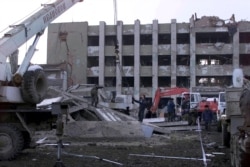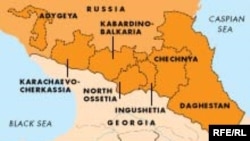Land Claims
Prigorodny Raion, which the Ingush regard as part of their ancestral land, was part of the Checheno-Ingush Autonomous Soviet Socialist Republic (ASSR) until that republic was abolished following the deportation of both Chechens and Ingush to Central Asia in 1944. The Prigorodny district was then designated part of the neighboring North Ossetian ASSR; but when the Checheno-Ingush ASSR was resurrected in 1957 following then Soviet leader Nikita Khrushchev's exoneration of the Chechens, Ingush, and other deported peoples, the border between that republic and North Ossetia was drawn in such a way as to leave Prigorodny district in North Ossetia.
Since the late 1980s, the Ingush have been lobbying, without success, to have that border redrawn. The conflicting claims of the Ossetians and Ingush to the district led to a short but brutal war in October-November 1992. Over 500 people died in the fighting and between 34,000 and 64,000 Ingush who had unofficially returned to Prigorodny district were forced to abandon their reclaimed homes and flee.
Since late 1992, the Ossetian authorities have dragged their feet over implementing successive plans drafted in Moscow to permit the Ingush to return to Prigorodny district. Consequently, as of early this year, only an estimated 12,500 had done so. Meanwhile, the competing claims on that territory have come to dominate relations between the two peoples, each of which continues to lobby Moscow tirelessly to rule in its favor.
Moreover, the perceived unwillingness or inability of the Ingush leadership to secure the formal return of Prigorodny district to Ingushetia has compounded popular resentment and even outright hatred of President Murat Zyazikov, who is widely perceived as corrupt and ineffective.
True, Zyazikov has consistently rejected the idea of restoring a combined Chechen-Ingush republic whenever that idea has been floated, although he has not publicly linked that rejection to the issue of Prigorodny district. But Zyazikov's opposition to the proposed territorial merger may well derive not so much from the desire to preserve Ingushetia's status as a separate republic as from the fear of losing his own job should Ingushetia be merged with Chechnya.
Part of Chechen parliament speaker Abdurakhmanov's stated rationale for recombining Chechnya and Ingushetia, as cited by Interfax on April 24, was that it would contribute to stabilizing the region and would "remove forever hotbeds of tension."
Kadyrov's Efforts
Certainly the energy with which Chechen Prime Minister Kadyrov has set about expediting the reconstruction of Grozny and creating new jobs in recent months, and the albeit grudging popular approval those efforts have met with, is in stark contrast to Zyazikov's failure to kickstart the stagnating Ingush economy or provide jobs for the republic's unemployed youth. (Ingushetia receives the largest percentage of its budget -- 89.2 percent -- from Moscow of any of the 89 federation subjects. Chechnya ranks in second place with 80. 6 percent, according to an article published in "Vedomosti" on March 14 and reposted on ingushetiya.ru.) In addition, Kadyrov has demonstratively positioned himself as guardian of both Chechen tradition and the Chechen variant of Islam.
On the minus side, the various official and semi-official Chechen police and security agencies that answer directly to Kadyrov continue to snatch young men off the streets in the same way that the Ingushetian Interior Ministry has done in recent years.
That tactic in Ingushetia has fuelled the influx of young Ingush into the ranks of what coalesced in late 1994 as the Chechen resistance, but is now a multinational fighting force that includes representatives of most, if not all, North Caucasus ethnic groups.
How many of the recent attacks on both Ingush and Russian security and law enforcement officials in Ingushetia (there have been at least five such attacks in the past month in which 14 people have been killed, including Deputy Interior Minister Djabrail Kostoyev and OMON special forces commander Musa Nalgiyev) were the work of such resistance groups can only be guessed at.
But in terms of the frequency of such attacks Ingushetia currently far outranks Chechnya and may soon eclipse Daghestan, which during the first nine months of last year witnessed 28 acts of terrorism and over 90 attacks on police that killed 42 Interior Ministry personnel and injured 92. Twelve civilians also died in those attacks and 41 were injured, according to "Izvestiya" on October 6, 2005.
Counterproposal
Ingush historian Beslan Kostoyev responded to Abdurakhmanov's trial balloon with a lengthy essay that was posted on June 3 on ingushetiya.ru. In that essay, Kostoyev chronicled successive encroachments on the lands the Ingush consider theirs, including designating the town of Vladikavkaz part of North Ossetia in June 1933 and the abolition in January 1934 of the Ingush Autonomous Oblast and its forced incorporation into the newly formed Checheno-Ingush Autonomous Oblast (subsequently upgraded to the status of an ASSR.)
He cited examples of what he construed as a recurring pro-Ossetian bias on the part of Chechen leaders dating back to the 1930s, and he pointed out that the impetus for abolishing the Checheno-Ingush ASSR in 1992 came from those Chechen leaders who had espoused the "insane idea" of creating an independent Chechen state.
Further, Kostoyev argued that trying at this juncture to reverse that separation of Chechnya and Ingushetia "would be exceedingly dangerous for the peoples of the North Caucasus and for Russia as a whole." Kostoyev went on to propose that instead, Ingushetia and North Ossetia be combined in a single republic, a move that would not only abolish their respective competing claims for jurisdiction over Prigorodny district but reduce the expense of maintaining two separate republican bureaucracies.
Mega-Caucasus Region
On the other hand, Kostoyev expressed approval for Abdurakhmanov's suggestion that Daghestan too become part of the new mega-North Caucasus region. But while Chechnya (population approximately 1 million) might conceivably manage to subsume Ingushetia, with a population of under 500,000, most of whom are ethnically and linguistically related to the Chechens, Daghestan, with a population of 2.5 million and dozens of unrelated ethnic groups in (sometimes literally) cut-throat competition for resources and jobs, could pose an intractable problem even for the seemingly indefatigable Kadyrov. And, crucially, Kadyrov will not turn 30 -- the minimum age at which he could be elected head of Chechnya and, by extension, of a larger territorial unit -- until October 2006.
Asked in an interview in the current issue of the Russian edition of "Newsweek" to comment on the idea of merging the three republics, Kadyrov said he considers it "possible, if the peoples of Ingushetia, Chechnya, and Daghestan want it, and when Chechnya becomes prosperous...but not yet because Chechnya is still in ruins."
Other Chechen officials, including administration head Alu Alkhanov and Nationalities Ministry official Vakhud Gerikhanov, pointed out that a merger between Chechnya, Ingushetia, and Daghestan would have to be put to a referendum in all three republics, according to Interfax on May 6 and regnum.ru on April 25. Daghestan National Assembly speaker Magomedsalam Magomedov predicted on April 26 that the overwhelming majority of voters in Daghestan would reject any such merger. Reports of an official visit last week to Makhachkala by a Chechen parliament delegation did not say whether the proposed merger was discussed.
To date, there has been no official comment from Moscow on Abdurakhmanov's proposal to create a new North Caucasus krai, although gazeta.ru on April 25 quoted a member of presidential envoy to the Southern Federal District Dmitry Kozak's staff as saying, "we are not considering any such initiatives at this point."
A merger of Ingushetia and Chechnya (with or without Daghestan) would leave North Ossetia free to unite at some future date with Georgia's breakaway Republic of South Ossetia, whose leader Eduard Kokoity announced in March that the republic will submit a formal request to the Russian Constitutional Court to rule that South Ossetia is part of the Russian Federation.
The Chechnya Conflict
 The aftermath of a December 2002 Chechen resistance attack on the main government building in Grozny (epa)
The aftermath of a December 2002 Chechen resistance attack on the main government building in Grozny (epa)
CHRONOLOGY
The fighting in Chechnya has raged, with short breaks, since 1994. It has brought misery, death, and destruction to the North Caucasus republic and to Russia as a whole. View an annotated timeline of the conflict.












